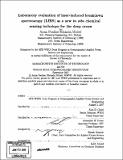Laboratory evaluation of laser-induced breakdown spectroscopy (LIBS) as a new in situ chemical sensing technique for the deep ocean
Author(s)
Michel, Anna Pauline Miranda, 1976-
DownloadFull printable version (14.40Mb)
Alternative title
Laboratory evaluation of LIBS as a new in situ chemical sensing technique for the deep ocean
Other Contributors
Woods Hole Oceanographic Institution.
Advisor
Alan D. Chave and Alexandra H. Techet.
Terms of use
Metadata
Show full item recordAbstract
Present-day expeditionary oceanography is beginning to shift from a focus on short-term ship and submersible deployments to an ocean observatory mode where long-term temporally-focused studies are feasible. As a result, a critical need for in situ chemical sensors is evolving. New sensors take a significant amount of time to develop; thus, the evaluation of techniques in the laboratory for use in the ocean environment is becoming increasingly important. Laser-induced breakdown spectroscopy (LIBS) possesses many of the characteristics required for such in situ chemical sensing, and is a promising technique for field measurements in extreme environments. Although many LIBS researchers have focused their work on liquid jets or surfaces, little attention has been paid to bulk liquid analysis, and especially to the effect of oceanic pressures on LIBS signals. In this work, laboratory experiments validate the LIBS technique in a simulated deep ocean environment to pressures up to 2.76 x 10⁷ Pa. A key focus of this work is the validation that select elements important for understanding hydrothermal vent fluid chemistry (Na, Ca, Mn, Mg, K, and Li) are detectable using LIBS. A data processing scheme that accurately deals with the extreme nature of laser-induced plasma formation was developed that allows for statistically accurate comparisons of spectra. The use of both single and double pulse LIBS for high pressure bulk aqueous solutions is explored and the system parameters needed for the detection of the key analytes are optimized. Using both single and double pulse LIBS, the limits of detection were found to be higher than expected as a result of the spectrometer used in this experimentation. However, the results of this validation show that LIBS possesses the characteristics to be a viable chemical sensing method for in situ analyte detection in high pressure environments like the deep ocean.
Description
Thesis (Ph. D.)--Joint Program in Oceanography/Applied Ocean Science and Engineering (Massachusetts Institute of Technology, Dept. of Mechanical Engineering; and the Woods Hole Oceanographic Institution), 2007. Includes bibliographical references.
Date issued
2007Department
Joint Program in Oceanography/Applied Ocean Science and Engineering; Woods Hole Oceanographic Institution; Massachusetts Institute of Technology. Department of Mechanical EngineeringPublisher
Massachusetts Institute of Technology
Keywords
/Woods Hole Oceanographic Institution. Joint Program in Oceanography/Applied Ocean Science and Engineering., Mechanical Engineering., Woods Hole Oceanographic Institution.